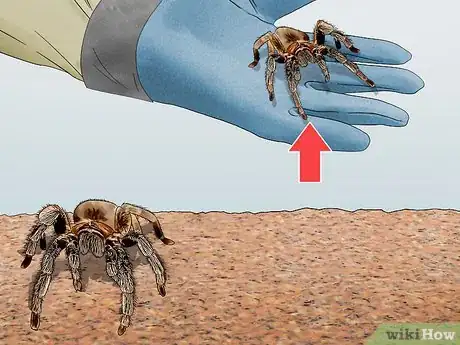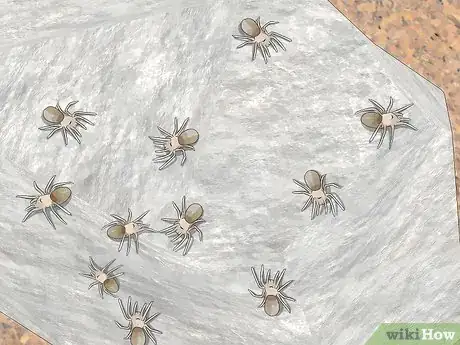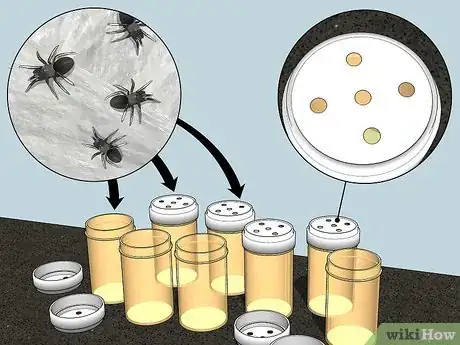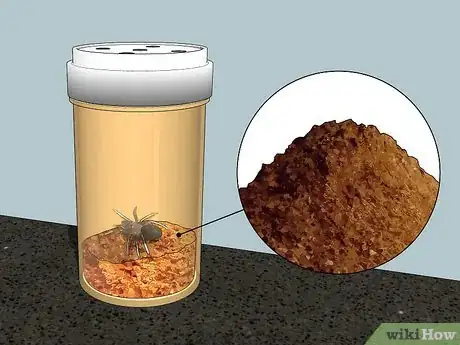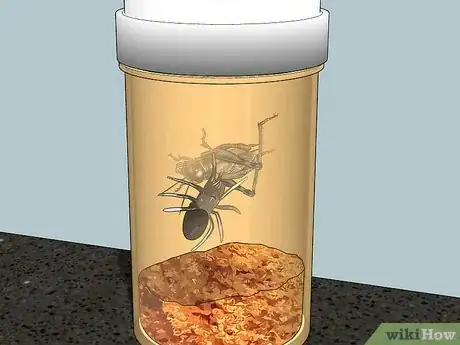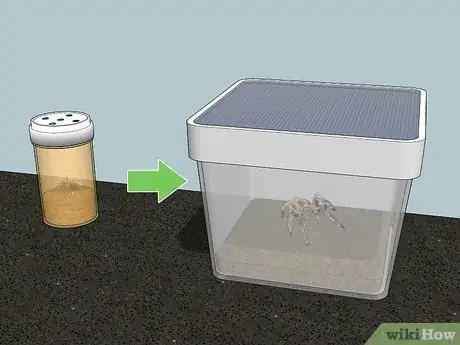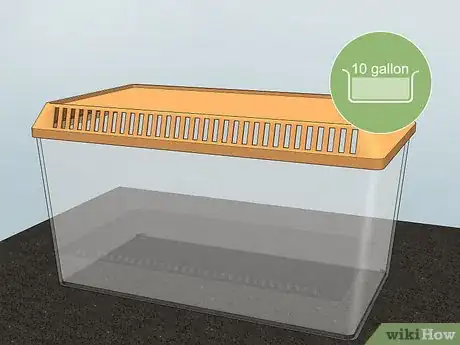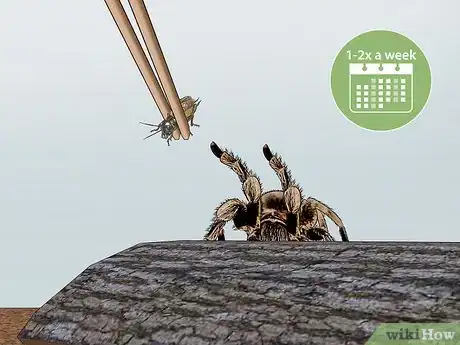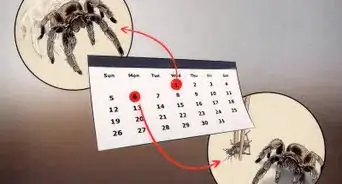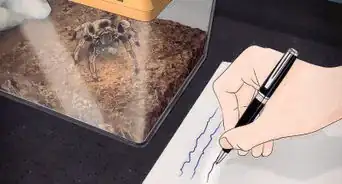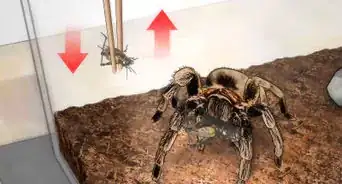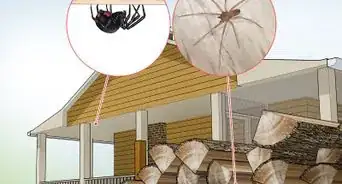This article was co-authored by wikiHow staff writer, Madeleine Criglow. Madeleine Criglow is a wikiHow Staff writer based in the Pacific Northwest. She has over six years of experience working in copywriting, editing, and journalism. In addition to her work for wikiHow, she writes a monthly film column for Tigard Life and Tualatin Life newspaper. Madeleine graduated from the University of Puget Sound with a BA in English with an emphasis in Creative Writing.
There are 14 references cited in this article, which can be found at the bottom of the page.
This article has been viewed 82,407 times.
Learn more...
Even though there are over 800 species of tarantulas that you can keep as a pet, they all have very similar mating habits, which means breeding them is actually pretty easy.[1] In order to successfully breed tarantulas, you need to have 2 of the same species. They need to be well-cared for and well-fed so they’re more receptive to mating with one another. After they mate, you also need to be ready to capture and remove the male tarantula before the female tries to eat him!
Steps
Mating Two Tarantulas
-
1Start feeding the female tarantula more food before you breed her. Female tarantulas are more likely to be receptive to breeding if there is an abundance of food. A few weeks before you plan to breed her, you need to give her as much food as she wants.[2]
- Give her as many crickets as she can eat and clean out any food that she doesn’t eat.
- A female tarantula will not mate if she hasn’t molted in the past 6 months. Molting is when a tarantula sheds its skin. If you find a dry, crusty tarantula shell in the habitat, then you know that they molted.
-
2Introduce a male of the same species into the female’s habitat. Place a male tarantula of the same species at the opposite end of the female in her habitat. Then, leave them undisturbed to allow the male to settle down and start its courtship process.[3]
- Never introduce a female into a male’s habitat or she will most likely kill and eat the male.
Advertisement -
3Rescue the male when he runs away after finishing mating. Breeding can take anywhere from a few minutes to a few hours, so keep a close eye on the 2 tarantulas to make sure the female doesn’t try to kill the male. As soon as the male lets go of the female he will try to run away. You need to catch and remove him before the female is able to catch him and kill him.[4]
- If the female gets a hold of the male before you can remove him, use a stick or a small paintbrush to separate them. Don’t use your fingers or you could get bitten!
- You can return the male to his habitat. He can breed again later or just go back to being a pet!
Tip: When they first touch, it will appear as though they are fighting as the male works to get his hooks under the female’s fangs so she can’t bite him. This is normal!
-
4Make sure the female is well fed. After you’ve removed the male from the female’s habitat, the female needs to be well fed so she can produce the egg sacs. When she’s ready, she will dig up some of the ground cover and start to lay her eggs. If she isn’t well fed, she may eat some or even all of the eggs.[5]
- The only way to know if the pair mated successfully is to wait to see if the female lays any eggs.
- Eventually, she will stop eating while she guards and rotates the eggs. You can stop giving her food when she stops eating, but you need to continue to give her water.
Raising Baby Tarantulas
-
1Wait about 10 weeks for the nymphs to appear. After a few months, tiny spiders, or nymphs, will start to emerge from the eggs. After about 3-4 days, they will turn dark and start to go through their first molt. Leave them alone until they’re finished molting. Once their first molt is complete, remove the mother so she doesn't eat any of them.[6]
- A tarantula egg sac usually contains between 100 and 1,000 spiderlings.[7]
-
2Separate the spiderlings into individual habitats or containers. Use pill bottles or small plastic containers. It's best to start spiderlings in small containers, working your way up to bigger ones as they grow.[8] Make sure the containers each have a ventilated lid so they don't escape.[9] To move the spiderlings, use a small paintbrush to gently nudge them into the new container. Be careful, as spiderlings are very delicate.[10]
-
3Add substrate to each container to give your spiderlings a hospitable environment. Use garden soil, sphagnum peat moss, or horticultural vermiculite.[13] These types of substrate help keep the spiderlings' habitat moist. This is super important to the health of your spiderlings, as tarantulas thrive in humid environments.[14]
- To add some humidity, regularly mist the spiderling containers with water. When misting, don't spray the spiderlings directly and make sure each container is dry in 1-2 days. If it's still wet, you're using too much water.[15]
-
4Feed your spiderlings pinhead crickets. Place 3-5 crickets in the spiderlings' habitats 1-2 times a week. If the spiderlings don't eat them within an hour, take the crickets out and put them back in a few days.[16]
- Pinhead crickets are smaller in size and perfect for your spiderlings. Always make sure the crickets aren't any larger than 1/2 of the spider's body length.[17]
-
5Use a heat mat to keep the spiderlings warm. Try placing a heat mat on the bottom of a large container (like a vivarium). Next, place all of the individual containers housing the spiderlings inside this container. This option works great to provide heat for all of your spiderlings without having to heat each container separately.[18]
- Keep the temperature between 70–80 °F (21–27 °C).[19]
-
6Move your spiderlings to larger containers as they get bigger. Spiderlings need a habitat at least 4 times the size of their leg span.[20] Once they outgrow their first small containers, move your spiderlings to clear cups ranging from 12 to 16 oz. When they get too big for these containers, move them to their permanent aquarium.[21]
- A spiderling will usually molt and grow in size every 3 months. As they get older and larger, they will molt once per year. A typical tarantula takes about 2-5 years to mature fully, with males maturing faster than females.[22]
- The average male tarantula will reach maturity after 2 years. Female tarantulas may need 2-3 more years.
Caring for Adult Tarantulas
-
1Use a 10 US gal (38 L) terrarium with a lid. Tarantulas are very good at escaping from their habitats, so you need to make sure the one you choose has a lid that can be sealed shut to prevent them from getting out. The lid also needs to be ventilated to allow fresh air to enter.[23]
- You can use an aquarium as a habitat, but make sure it has a lid that seals shut.
- It can help to put a book or something heavy on top of the lid of the habitat to make sure the tarantula can’t get out.
- Tarantulas are very territorial, so never keep 2 in the same habitat, except to breed them. This terrarium will primarily house your female tarantula, and you'll introduce the male tarantula right before breeding.
-
2Add a 2 in (5.1 cm) layer of ground cover on the bottom of the habitat. Form an even layer of vermiculite 1.5 inches (3.8 cm) thick and cover it with a thin, 1⁄2 in (1.3 cm) layer of chipped bark or cocoa fiber. Use a spray bottle to lightly dampen the material in order to keep up the humidity levels in the habitat.[24]
- You can purchase vermiculite and chipped bark or cocoa fiber at pet supply stores or even garden supply stores.
- Don’t use potting dirt or compost because it may not be sanitary for your tarantula.
- If you have a species of tarantula that likes to dig or burrow, you may need to make a layer about 6 inches (15 cm) deep.
-
3Place a hollow log, small branches, and rocks in the habitat. Tarantulas need an area to hide in during the day.[25] Place a hollow half-log in the tank so your tarantulas have a shelter and try to make them feel more at home by adding some small branches, rocks, and leaves. The more comfortable your tarantulas are, the more likely they are to breed.[26]
- You can use a hollow log that you find outside, but make sure it’s clean and dry so it doesn’t rot in the habitat. You could also purchase one from a pet supply store.
- Use a broken ceramic pot as a shelter by burying the edges in the ground cover so it’s nice and dark inside of it.
- Make sure the entrance to the shelter is large enough for the tarantula to fit through.
Tip: If you have tree-dwelling tarantulas, they will want to make a nest in branches. Lean some twigs and branches against the wall of the habitat so they can climb them and make a nest. Don’t add branches if you have ground-dwelling tarantulas or they could fall and injure themselves.
-
4Install a thermometer to monitor the temperature in the habitat. Most tarantulas need to live in an environment with a temperature between 70–76 °F (21–24 °C).[27] Add a thermometer to the wall inside of the habitat so you can get an accurate temperature reading. If you have your habitat in a room that stays around this temperature consistently, then you don’t need any extra heating equipment.[28]
- If your habitat is colder, then use an electric heat-mat to heat one half of the tank so your tarantulas can regulate their body temperature by moving to the warm or the cooler side of the habitat.
- Don’t let the habitat get warmer than 86 °F (30 °C) or it could harm your tarantulas.
-
5Put a humidity gauge on the wall inside of the habitat. Tarantulas require a 50% humidity level in their habitat in order to survive. Spray some water on the ground cover with a spray bottle to raise the humidity level if you need to.[29]
- Keep an eye out for mold inside of the habitat.
- If the humidity gets higher than 80%, ventilate the habitat by opening the cover to let some of the humidity out. Either move your tarantulas to another habitat or hold them in your hands until the humidity level goes down.
-
6Feed your tarantulas 1-2 crickets per week. Most tarantulas only require 1 or 2 crickets a week but some larger species can eat up to 6 crickets.[30] Make sure the crickets that you feed your tarantulas are “gut loaded” or well fed to provide better nutrition.[31]
- You can purchase live crickets at pet supply stores or you can order them online.
- Consider raising your own crickets so you have a continuous supply of healthy, live crickets for your tarantulas.
-
7Fill a small water dish with fresh water. Put a small container at the bottom of the habitat and keep it filled with filtered, chlorine-free water. Place a rock in the center of the dish so any crickets that get into the water won’t get trapped and decompose in the water.[32]
- Change the water if it starts to build up any scum on the surface.
Community Q&A
-
QuestionHow soon after a fertile sac is laid can I re-pair the female with another male? Do I have to wait until the female molts again?
 Community AnswerYes. You have to wait until the female molts again to pair. I would not recommend doing it right after the female has laid the fertile sac.
Community AnswerYes. You have to wait until the female molts again to pair. I would not recommend doing it right after the female has laid the fertile sac. -
QuestionWhat type of insects should I feed a baby tarantula?
 Community AnswerCrickets and tiny bugs, like cicadas, grasshoppers, sow bugs, caterpillars, and beetles.
Community AnswerCrickets and tiny bugs, like cicadas, grasshoppers, sow bugs, caterpillars, and beetles. -
QuestionMy pulchripes doesn't eat for almost a month, and noticed some bald spots that aren't black. What could be the possible reason?
 Community AnswerPre-molt. Don't worry, just make sure it always has water. It will lie on its back when ready to molt. Don't flip or disturb it. Don't feed your tarantulas for a while after molting; it's still fragile and the prey might hurt it.
Community AnswerPre-molt. Don't worry, just make sure it always has water. It will lie on its back when ready to molt. Don't flip or disturb it. Don't feed your tarantulas for a while after molting; it's still fragile and the prey might hurt it.
Things You’ll Need
- A 10 US gal (38 L) terrarium
- Hollow log
- Small branches or twigs
- Vermiculite
- Chipped bark or cocoa fiber
- Spray bottle
- Thermometer
- Humidity gauge
References
- ↑ https://www.sciencedaily.com/terms/tarantula.htm
- ↑ https://www.tarantulaguide.com/tarantulas-food-water-diet/
- ↑ https://www.giantspiders.com/captive-care/breeding/
- ↑ https://bugguide.net/node/view/184115
- ↑ https://www.giantspiders.com/captive-care/breeding/
- ↑ https://www.giantspiders.com/captive-care/breeding/
- ↑ https://www.livescience.com/63428-tarantula-baby-egg-sac-video.html
- ↑ https://www.keepingexoticpets.com/care-tarantula-spiderlings/
- ↑ https://www.petful.com/other-pets/pet-tarantulas-for-beginners/
- ↑ http://www.tarantulas.com/spiderlings.html
- ↑ https://blogs.cornell.edu/spiders/tarantulas-terrible-or-terrific/
- ↑ https://www.keepingexoticpets.com/care-tarantula-spiderlings/
- ↑ http://www.tarantulas.com/spiderlings.html
- ↑ https://www.keepingexoticpets.com/care-tarantula-spiderlings/
- ↑ http://www.tarantulas.com/spiderlings.html
- ↑ https://entomology.ca.uky.edu/content/exotic-bugs-care-and-feeding
- ↑ https://entomology.ca.uky.edu/content/exotic-bugs-care-and-feeding
- ↑ https://www.keepingexoticpets.com/care-tarantula-spiderlings/
- ↑ https://www.tarantulaguide.com/pet-tarantula-cage-and-habitat/
- ↑ https://www.keepingexoticpets.com/care-tarantula-spiderlings/
- ↑ http://www.tarantulas.com/spiderlings.html
- ↑ https://www.keepingexoticpets.com/how-fast-do-tarantulas-grow/
- ↑ https://www.petful.com/other-pets/pet-tarantulas-for-beginners/
- ↑ https://www.amentsoc.org/insects/caresheets/tarantula.html
- ↑ https://www.tarantulaguide.com/pet-tarantula-cage-and-habitat/
- ↑ https://www.petful.com/other-pets/pet-tarantulas-for-beginners/
- ↑ https://www.tarantulaguide.com/pet-tarantula-cage-and-habitat/
- ↑ https://www.amentsoc.org/insects/caresheets/tarantula.html
- ↑ https://www.amentsoc.org/insects/caresheets/tarantula.html
- ↑ https://blogs.cornell.edu/spiders/tarantulas-terrible-or-terrific/
- ↑ https://www.tarantulaguide.com/tarantulas-food-water-diet/
- ↑ http://www.thebts.co.uk/keeping_tarantulas.html


